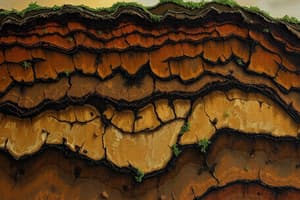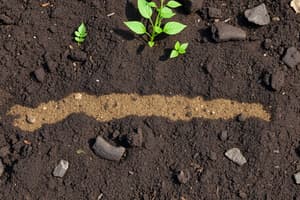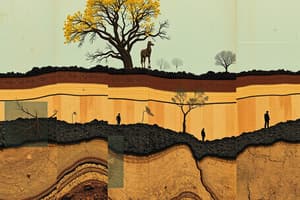Podcast
Questions and Answers
What is the primary process through which soil is formed from rocks?
What is the primary process through which soil is formed from rocks?
- Transportation
- Erosion
- Weathering (correct)
- Decomposition
Which of the following is a key factor influencing soil fertility?
Which of the following is a key factor influencing soil fertility?
- Presence of nutrients (correct)
- Type of vegetation
- Elevation
- Soil color
What distinguishes residual soil from transported soil?
What distinguishes residual soil from transported soil?
- Residual soil forms in the same location as its parent rock. (correct)
- Residual soil is less fertile than transported soil.
- Residual soil is formed by human activity.
- Transported soil does not contain organic matter.
Which type of soil is known for its high fertility and is often found in river plains?
Which type of soil is known for its high fertility and is often found in river plains?
What is a defining characteristic of Khadar soil compared to Bangar soil?
What is a defining characteristic of Khadar soil compared to Bangar soil?
Which soil type is prone to cracking in dry seasons due to its texture?
Which soil type is prone to cracking in dry seasons due to its texture?
Which soil is primarily found in regions with high rainfall and intense sunlight, leading to nutrient leaching?
Which soil is primarily found in regions with high rainfall and intense sunlight, leading to nutrient leaching?
What is a major nutrient deficiency in red soil?
What is a major nutrient deficiency in red soil?
Which type of soil erosion is characterized by the formation of deep channels?
Which type of soil erosion is characterized by the formation of deep channels?
What is a major human activity that contributes to soil erosion?
What is a major human activity that contributes to soil erosion?
Which region in India is noted for having the highest rates of soil erosion?
Which region in India is noted for having the highest rates of soil erosion?
What type of soil is known to be found in Assam?
What type of soil is known to be found in Assam?
Which soil conservation technique involves alternating the planting of different crops?
Which soil conservation technique involves alternating the planting of different crops?
What natural agent is responsible for sheet erosion?
What natural agent is responsible for sheet erosion?
Which conservation method is NOT mentioned as a government initiative?
Which conservation method is NOT mentioned as a government initiative?
Which factor contributes least to soil erosion during monsoon seasons?
Which factor contributes least to soil erosion during monsoon seasons?
What effect does overgrazing have on soil?
What effect does overgrazing have on soil?
Which soil type is predominantly found in the Thar Desert?
Which soil type is predominantly found in the Thar Desert?
Flashcards
Weathering
Weathering
The process of breaking down rocks into smaller particles, often by exposure to weather elements like wind, rain, and ice.
Soil
Soil
The topmost layer of Earth, composed of broken-down rocks mixed with organic matter, essential for plant life.
Soil Fertility
Soil Fertility
The ability of soil to provide the right conditions for plants to thrive, including moisture retention, nutrient availability, and sufficient depth for root growth.
Residual Soil
Residual Soil
Signup and view all the flashcards
Transported Soil
Transported Soil
Signup and view all the flashcards
Alluvial Soil
Alluvial Soil
Signup and view all the flashcards
Black Soil
Black Soil
Signup and view all the flashcards
Red Soil
Red Soil
Signup and view all the flashcards
Soil Erosion
Soil Erosion
Signup and view all the flashcards
Sheet Erosion
Sheet Erosion
Signup and view all the flashcards
Rill Erosion
Rill Erosion
Signup and view all the flashcards
Gully Erosion
Gully Erosion
Signup and view all the flashcards
Stream Bank Erosion
Stream Bank Erosion
Signup and view all the flashcards
Deforestation
Deforestation
Signup and view all the flashcards
Overgrazing
Overgrazing
Signup and view all the flashcards
Shifting Cultivation
Shifting Cultivation
Signup and view all the flashcards
Unsustainable Agricultural Practices
Unsustainable Agricultural Practices
Signup and view all the flashcards
Shelter Belts
Shelter Belts
Signup and view all the flashcards
Study Notes
Soil Formation
- Soil forms from the breakdown of rocks, called weathering, and the decomposition of organic matter from plants and animals.
- Soil is the topmost layer of the Earth, crucial for life.
Soil Fertility
- Soil fertility describes soil's ability to support plant growth.
- Factors influencing soil fertility include:
- Moisture retention capacity
- Soil depth for root growth
- Nutrients like nitrogen, phosphorus, and potassium (NPK)
- Organic matter content from plant and animal decomposition
Soil Types
- Residual Soil (In-situ soil): These remain where the parent rock formed.
- Example: Black lava rock forms black soil in the same location.
- Transported Soil (Ex-situ soil): Forms from parent rock material moved by erosion (wind, rivers).
- Examples: Alluvial soil from mountain sediments deposited in plains.
- Alluvial Soil:
- Highly fertile, rich in minerals.
- Commonly called "Silt soil," a mix of sand, clay, and silt.
- Found in river plains (Indus, Ganges, Brahmaputra); and deltas (Mahanadi, Godavari) and coasts.
- Subtypes:
- Khadar: Recent flood deposits, lighter and fertile.
- Bangar: Older, less fertile, with nodules and gravel.
- Black Soil (Regur Soil / Black Cotton Soil):
- Forms from black lava rock weathering, rich in clay.
- Primarily found in Maharashtra and Gujarat.
- Fine texture, sticky, water-retentive, prone to cracking in dry seasons.
- Suitable for cotton, jowar, wheat, sugarcane, but lacks nitrogen and phosphorus.
- Red Soil:
- Forms from crystalline rock weathering, red from high iron oxide content.
- Found in Tamil Nadu, Karnataka, and elsewhere.
- Low in nitrogen, phosphorus, and potassium.
- Lighter, airy, porous, but not highly fertile.
- Suitable for vegetables, rice, ragi, and tobacco.
- Laterite Soil:
- "Brick soil," easily cut into bricks.
- Forms in regions with high rainfall and intense sun, leading to nutrient leaching.
- Found in the Western Ghats.
- Low fertility due to nutrient leaching, lacks humus and lime.
- Used for construction material.
- Suitable for tapioca, turnip, cashew, tea, and coffee.
Soil Erosion
- Topsoil removal by natural forces like wind and water.
- Types of soil erosion:
- Sheet Erosion: Thin topsoil removal on gentle slopes.
- Rill Erosion: Rainwater forms small channels (rills) on slopes.
- Gully Erosion: Rills deepen, creating large channels. Most severe.
- Stream Bank Erosion: Riverbanks erode due to water flow.
- Contributing factors:
- Deforestation: Reduced soil holding capacity.
- Over-grazing: Exposed soil from vegetation removal.
- Wind Erosion: Soil movement in areas with low vegetation.
Soil Erosion Causes
- Deforestation
- Shifting cultivation
- Overgrazing
- Wind erosion
- Human population growth
- Unsustainable agricultural practices
- Monsoonal rainfall and floods
- Heavy rainfall can cause erosion.
Soil Erosion in India
- Soil erosion in India linked to outdated farming, deforestation, and geological features (water runoff, wind).
- Rajasthan and Madhya Pradesh have high erosion rates.
- High erosion regions include:
- Jambl and Yamuna Badland
- Western Himalayan Piedmont Zone
- Chhota Nagpur Plateau region
Soil Conservation Techniques
- Terracing and contour planting reduce water runoff, especially in hilly areas.
- Shelterbelts (windbreaks) reduce wind velocity and erosion.
- Strip cropping (alternating crops) controls erosion.
- Dams and gully plugging manage flooding.
- Tree planting for soil cover.
Government Initiatives and Soil Conservation
- Indian government programs to combat soil erosion include:
- Integrated Waste Management System
- Catchment areas for flood management
- Integrated Watersheds to manage water flow
- Land reclamation after floods
- Programs to discontinue shifting cultivation
- Encouraging bio-fertilizers.
Soil Conservation at the Individual Level
- Rainwater harvesting reduces runoff and replenishes groundwater.
Soil Types in India
- Various soil types across India, including:
- Mountain Soil (Jammu and Kashmir)
- Forest Soil (Jammu and Kashmir)
- Alluvial Soil (Punjab, Delhi, Haryana, Uttar Pradesh, Bihar, West Bengal, Assam)
- Red Soil (Tamil Nadu, parts of Madhya Pradesh, Odisha)
- Black Soil (Gujarat, Maharashtra, Madhya Pradesh)
- Laterite Soil (Western Ghats, Assam's Garo, Khasi and Jaintia Hills)
- Arid Soil (Thar Desert)
Studying That Suits You
Use AI to generate personalized quizzes and flashcards to suit your learning preferences.




